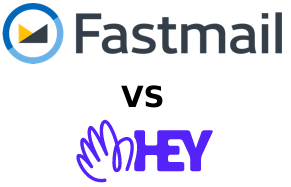
Last year when I heard that the Basecamp team was having a crack at transforming email I was very excited. I had been trying to get off of Gmail, which had been my main stay personal and corporate email system for some time. It was part of my efforts to get out of the walled gardens of Google etc, see this post from back in 2018. I initially tried a service called KolabNow but it just didn’t cut it at all. I therefore ended up doubling back to Gmail. I got a trial subscription to Basecamp’s new hey.com email service during the pre-release period. I liked it enough to pay for a full year of it for $99 and figured I’d work through my growing pains and shortcomings. I never did. Recently someone turned me on to another service option Fastmail which I’ve been playing with considerably during this 30 day trial. I’m sufficiently impressed that not only am I going to ditch hey.com but I can probably now properly ditch Gmail as well. Below is a detailed discussion of the pros and cons of each.
Introduction
The two big things that drew me into the hey.com pitch for “transforming email” were the blocking of spy pixel blocking (a mechanism an e-mail service uses to surreptitiously track whether you read an email or not) and supposedly a new workflow which would substantially cut down on the volume of email you have to process. They basically created a main landing area they called “Imbox” (not inbox) which is your main list of emails. The two other places emails can go, besides the trash, is a “paper trail” which was for transnational things you wanted to keep but not really needed to see necessarily, and “The Feed” which was for newsletters, product offers from companies etc. This created a landing page presentation that looks like this:
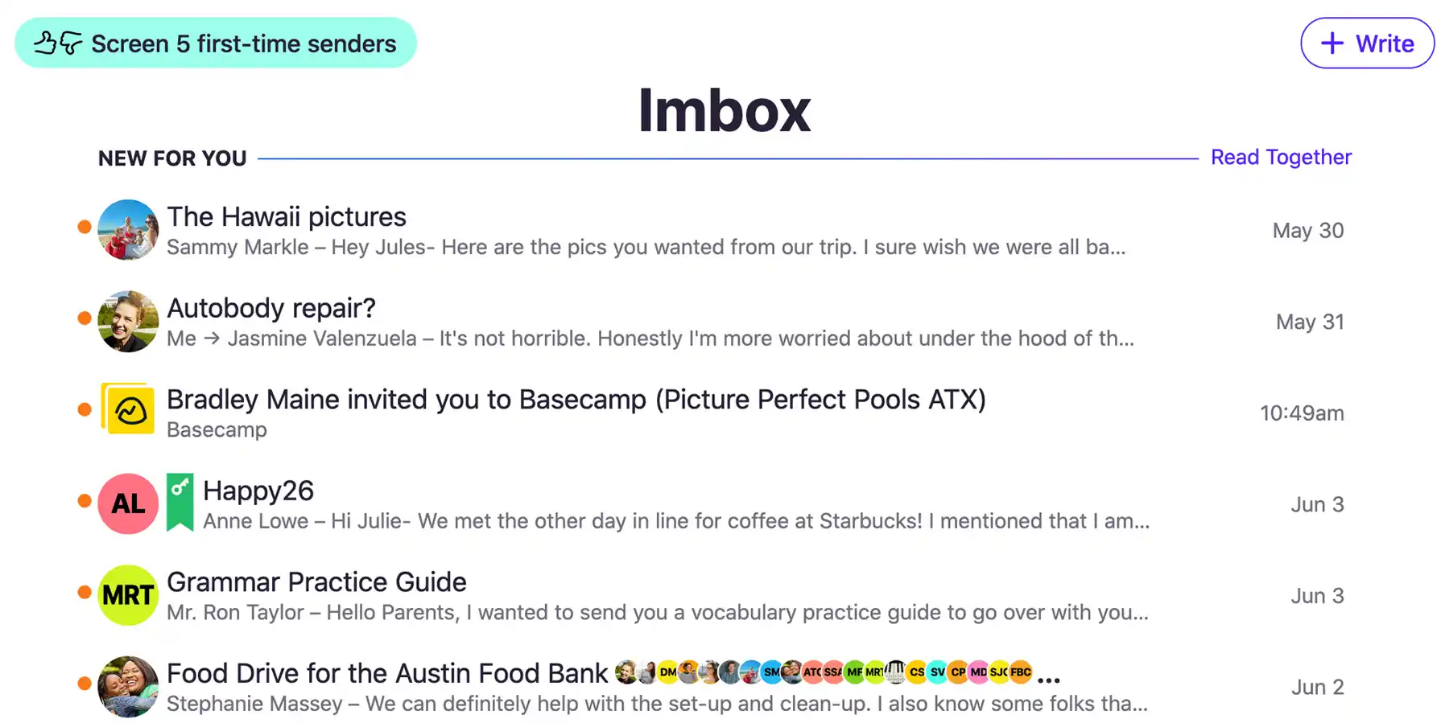
Hey.com Imbox
The Gmail workflow was very much cluttering up my email world and sucking me into my penchant for reflexively responding to things. The blocking of spy pixels was just an added bonus. Plus, as I have stated elsewhere, I’m sick of all of our network resources being consolidated into a handful of companies. It’s not just a question of if they are or are not doing nefarious things with that concentration. They could be the most benevolent good natured companies in the history of the planet and I’d still feel the same way because I don’t want that much consolidation. With that mindset in mind I dove into hey.com and liked it enough to give them a serious shot. Unfortunately there are major shortcomings, deal breaking shortcomings, that I was more than struggling with. That already had me looking about maybe once again having to go crawling back to my Gmail system. Fortunately my conversations on social media about a contentious episode at Basecamp, my opinion on that detailed in this post , led me into a discussion about alternatives to Gmail with Danilo Campos . His favorite service recommendation for that is Fastmail . On first glance it looked like not necessarily a good fit but it did solve a few of the problems I had with hey.com, which I’ll detail shortly. I decided to run it through its paces and quickly took a strong liking to it. First let’s look at the big picture items.
Big Ticket Item Comparison
First big picture item that I liked about hey.com was the spy pixel blocking. I’m not sure why I thought their handling that was innovative, except for the fact that I’ve been in Gmail so long it was moot if it was a concern. However Fastmail has been blocking spy pixels for a long time now. With that out of the way the big question was reproducing the other thing that drew me to hey.com which was the new workflow. The bottom line though is that while the notion behind the hey.com workflow was good there were some problems with it. Also the workflow itself is really a glorified email folder hierarchy with rules and a special presentation. Fastmail has a very powerful rules system and the ability to do folders. I was therefore able to not only reproduce the workflow idea of a Paper Trail and Feed that I had with hey.com, I was able to fix many of the things I didn’t like in hey.com’s implementation. With the two big comparable things discussed and there being parity on one and Fastmail being better on the other let’s discuss two of the biggest hey.com deficiencies that Fastmail fixes for me.
By far the biggest deal breaker problem for me was the lack of calendar integration. The company heads, product managers, etc. are pretty proud of the fact that their internal team doesn’t use calendars and instead uses their own Basecamp software for collaboration. They rightfully point out that calendars can be hard to implement so they decided it was better to release a system earlier without it than wait a long time to get calendars right. However the situation with calendars is not just a small point. First, in order to completely ditch Gmail I have to be able to host a calendar somewhere. I don’t want to get just go to Apple, another FAANG company , even if they are better on user data mining, so I would need to look at a whole external calendar hosting system. I did try to come up with something using Basecamp, although that is sort of like using a roll of aluminum foil to cut meat. Technically you can do that but you are really missing the point of the tool at hand. That wouldn’t have been the end of the world except for the fact that I couldn’t come up with a smooth workflow between hey.com and Basecamp for the calendar management. It was beyond unwieldy. So sticking with hey.com I was at the very least stuck with using Google Calendar. That was only part of the problem though. When there is mail/calendar integration the system can actively look for new calendar attachments etc and incorporate them into your calendar automatically. It also can pick up meeting updates and cancellations through that process too. I got so used to that just happening automagically that when I started missing meetings because that synergy was gone it was very grating. Fastmail has a great calendar system. The only thing I wish it did that only Google does is allow me to color code within a calendar instead of reproducing that behavior with multiple calendars. Fastmail therefore solved one of my huge hey.com problems out of the gate.
The hey.com system also bit me on my contacts management. Yes, hey.com has contacts management. However hey.com is priding itself on being just email. That means that the only information about contacts that hey.com will track is their name and their email address. That’s it. Phone numbers, addresses, notes, multiple email address types, etc. are not a thing to it. This is a standard contact management thing that I’ve been relying on since the I bought Sidekick 95 last century. Therefore the best case scenario with hey.com would be that I would need to maintain Google Contacts or jump to Apple for that sort of service. Fastmail again comes to the rescue by having full fledged contact management integration.
The last aspect of hey.com that bit me was that the only way one can interact with hey.com is through their website or one of their mobile apps. They are trying to re-imagine email. Therefore it doesn’t support the standard email services like IMAP or SMTP. If it did it may have been possible to partially overcome some of the calendar and contacts issues. Their rationale is they need to have end to end control of the system to do their message management and spy pixel blocking. Not being able to use standard clients on mobile bothered me but it was less of a problem on the desktop since I have long been a web-based email person. Fastmail has its own mobile client too but it supports all of the standard protocols. That means that I have the choice of accessing my data. I can use their app, Thunderbird, Apple Mail, or whatever I like. The spy pixel blocking can be replicated in the thick client apps if I chose not to use their web app or mobile app. However I actually find their mobile app very useful, far more useful than hey.com’s and the default Apple one for email. I therefore have settled into a workflow where I’m using Fastmail’s app for email and the standard address book and calendar app on my mobile device. All of that data is perfectly synced across all of those systems. That gives me the added bonus of things like if I book tickets with my airline app then it generates a calendar notification that can be automatically absorbed into my Fastmail hosted calendars. I’m back to never having to worry about keeping that stuff up to date again!
Even at just this high level there was enough benefit to Fastmail for me to switch but the deeper I went into experimenting with Fastmail the more convinced I was at how superior of a product they were for me.
In Depth Features
The first in depth feature I want to look at is the rules engine for email sorting. As I wrote above the bucketing system of “The Feed” and “Paper Trail” that hey.com is using is really just the usual folder and email rules but with a specific presentation style. For most things this worked pretty well but there were more than a few cases where it just wasn’t getting me the control I needed. For example since it works on the email sender’s address there was no way to have different emails from the same sender go to different places. I have a couple of subscriptions where the daily and weekly newsletters come from the same address. I want the weekly one to land in my Imbox and the others to either be filtered out entirely or head to “The Feed”. There is another that sends multiple digests a day but I only wanted one. There was no way to get hey.com to do it. I therefore shuttled all of them off to “The Feed” where I often forgot about them or to my main Imbox where they cluttered things up. Fastmail on the other hand has a full email rules engine behind it. It allows me to adjudicate these things exactly as I want. It’s even so flexible that you can write your own scripts rather than use the UI for it, which I haven’t needed to do yet. Not only does the rules engine allow me to change where things go it also lets me decide things like showing read/unread status, whether they are pinned etc. Combined with the UI improvements Fastmail creates a much better experience while letting me reproduce the “noise reduction” aspects hey.com was going for.
The UI for Fastmail is better in several ways. First, it supports drag and drop. If I need to move something from one folder to another, or archive, I can literally just drag it from one place to another. Second, it supports multi-select. When there was a batch of emails that I wanted to do the same thing to under hey.com I had no choice but to do it one by one. Fastmail allows me to do that. It also gives me control over filtering and sorting of the folder/inbox so that I can do something like “just show me the unread emails, select all, and mark as read.” That sort of workflow was impossible under hey.com. Beyond that the information density of the hey.com interface was way too low for me. First the main Imbox and Paper Trail screens, see above, are fine for some cases but as the only way to view lists is way too information sparse. “The Feed” is worse. The feed is supposed to come across as a social media timeline sort of thing. So you get something like this:
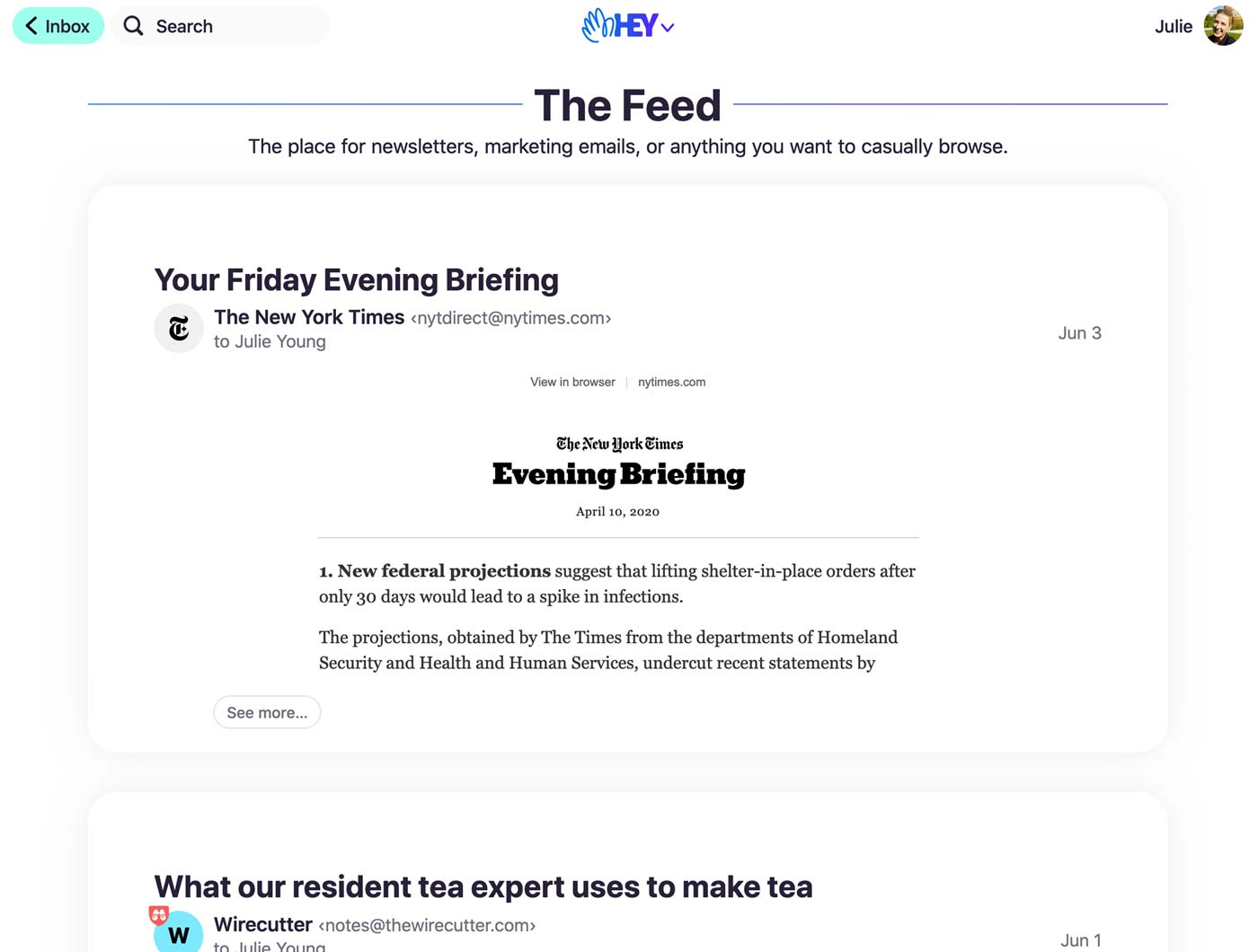
Hey.com ‘The Feed’
The information density of this is even lower. The compromise is supposed to be that you can see the previews. The problem is once I’ve read the stuff on the top there is no way to dismiss it, or minimize it to get to the stuff below. Do I want to catch up on stuff from earlier in the week? Scroll down a ton or try to figure out a search that’ll do it. This information density problem also comes with the emails themselves. There is no way to get a combined list view plus email view. Clicking on the email brings up a new screen with just those emails. Need to jump back and forth between the two? Well that’s too bad. By contrast Fastmail provides the ability to customize these things by dragging around elements just like you can in traditional email clients like Exchange, Thunderbird, etc. I also can bring up the folders view hierarchically. By combining these things I get the “reduce noise” effect of hey.com’s Feed and Paper Trail but with far better information density and therefore usability. Here is my typical view of the day:
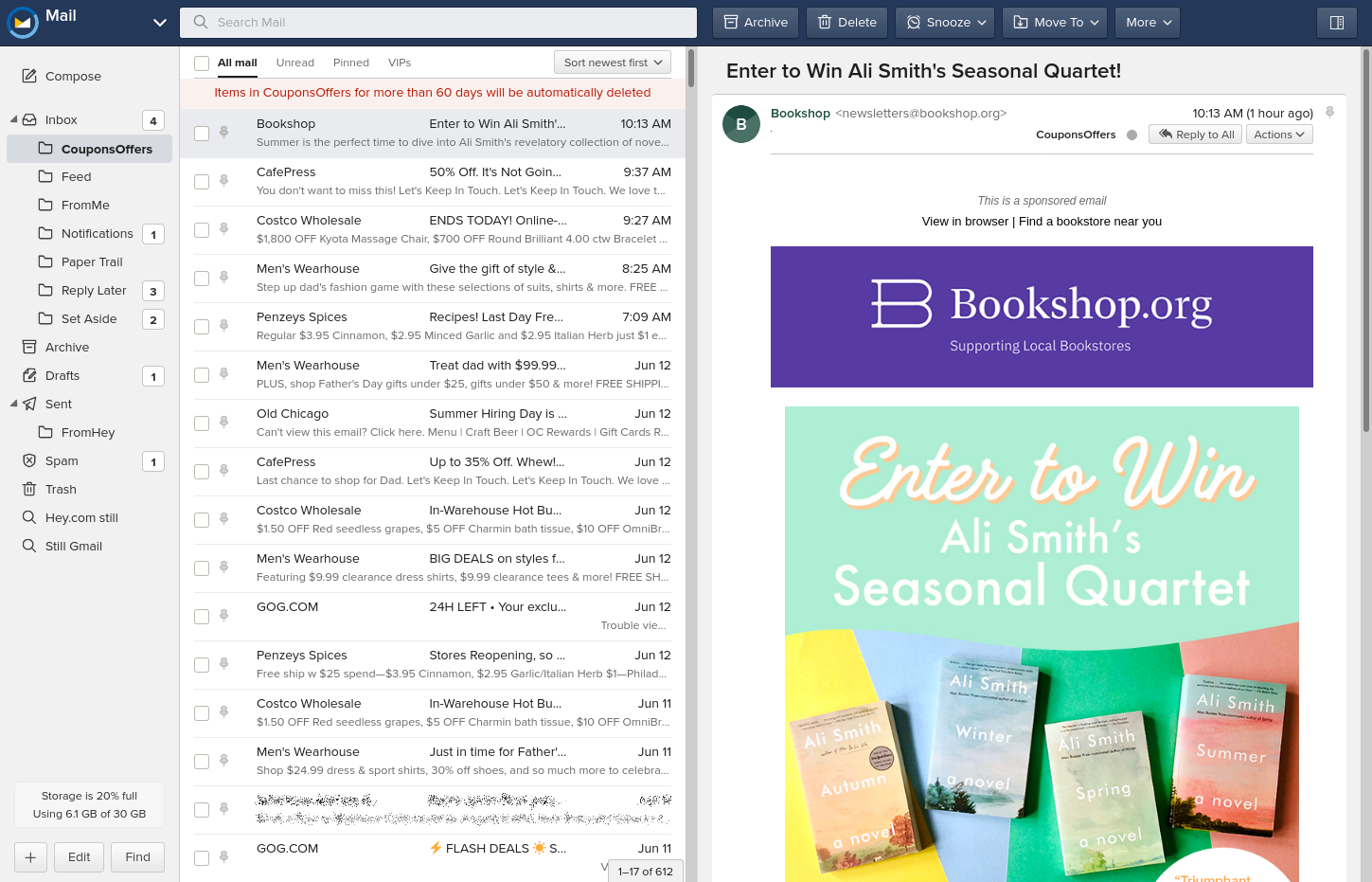
Fastmail Layout
Because I have more control over the rules I’m able to reduce the noise by having stuff I don’t want to see marked as “read” as it is sent to its respective folders. If I decide that I want one particular item with a rule to be adjudicated differently I can just drag it between folders. I have the full list of emails alongside the preview. All of this is in the browser with blocking of scripts and spy pixels. I will admit that if a tech scared person was trying to do this then the hey.com experience may be a better choice for them. However as I’ll show in a bit, setting up rules is made pretty simple by Fastmail. Still I’ll concede that for that sort of user they may find this process a bit too cumbersome. For me though it is perfect. The hey.com UI had bigger problems than just information density though. Discoverability/search was a major problem for me.
I’m used to email threads from the Gmail system. I’m also used to a straight chronological view from years of using traditional email clients. Hey.com tries to do more of a thread mechanism like Gmail however something about the way they did it made finding emails within them extremely difficult. Several times I’d respond to an email and then later in the day I’d try to find the conversation thread. It was very difficult to do. In the Fastmail client the main list shows a chronological view but once I click on an email the editor panel shows it in a thread like below:
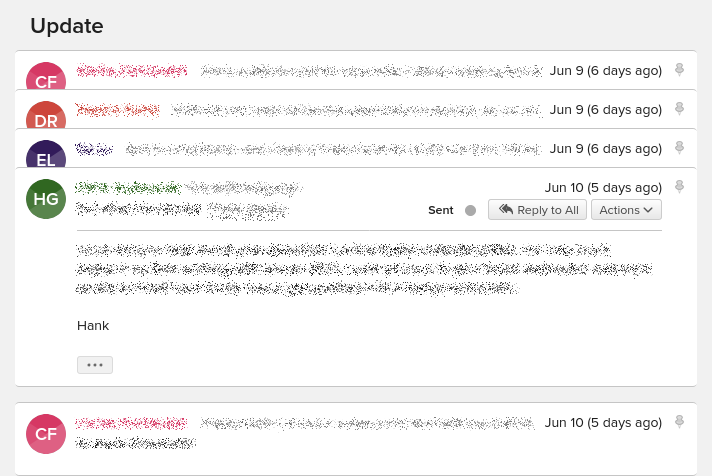
Fastmail Hierarchical View Editor Panel
Not only does this make it easy to jump between emails but it gives me all of the controls I need all in one place, additional controls at the top like in the previous screenshot. Once I find the email chain I’m looking for in hey.com I get a similar view, which takes over the panel whole window though, but the similarity ends there. Do I want to read something in the middle of the list? I can just click on it on both. Once I’m done if I want to collapse it I have no mechanism for that in hey.com but Fastmail supports it. Hey.com has an ellipsis button with the ability to respond to an individual email but the big in your face UI elements are a “reply and reply all” button at the bottom. Is that replying on the bottom of the thread the email I’m reading in the middle of the chain or something else? It is ambiguous. Trial and error will get you there but there is no reason for having that sort of ambiguity. Fastmail doesn’t have that. This was all after we found the email we were looking for in the pile of course. Both have searches but Fastmail’s works far better.
There have been many times where I didn’t know the exact email address or topic of email and I tried to use the hey.com search which came up with nothing. Sometimes I’d have to resort to manually searching the list laboriously. Because I hadn’t transitioned a lot of my email from Gmail, they were just reflected, often times I had to jump into Gmail itself to find what I was looking for and then search on the specific sender and scroll down to the specific date. Fastmail’s flexible search engine isn’t as good as Google’s, especially when I didn’t know exact addresses, but it is light years ahead of hey.com’s. Their’s also has an advanced mode so I could make compound searches and see the results. This has worked almost every time so that I haven’t had to jump back to Gmail for searching. What’s even better is that they have a very easy workflow for creating searches based on a selected email. With an email highlighted in the list view it automatically fills in a list of suggested searches based on recipient and an “Advanced search…” option. Once you’ve typed a search and you like it you can create a new rule with one button click. You even get to preview that rule across all of your messages before telling it to apply it to all existing emails or just that one. This allows one to create new rules in seconds, even with complex search requirements. Pretty much all of the ease of use in the configuration of rules hey.com therefore is gone. Search on hey.com was further limited by its lack of data import ability.
When I moved to hey.com I accepted the fact that my years of history of all of my accounts were stuck in those accounts. The hey.com experience would be limited to email sent to my hey.com address and any reflected email from that point moving on. I therefore could never turn off the old email systems if I didn’t want to lose access to those emails in the cloud. Fastmail however supports data import both with IMAP, Calendar files etc. They even have the ability to import directly from major providers using single sign on. I was therefore able to completely import my entire Gmail email archive into Fastmail. It didn’t even take long enough for me to worry about timing it. Because hey.com supports exporting data to mbox files I was also able to import my entire hey.com archive into that as well. With a better rules engine than I had with Gmail I was actually able to also adjudicate all of the emails into their respective folders as well. Along with some other email accounts I was also able to merge in this has given me all of my email history all in one place, perfectly searchable and viewable. With the auto-purge settings at the folder level I’m able to also have Fastmail cleanup the “noisy” emails over time that I don’t want to worry about while permanently storing everything else! Because it supports any client I also now finally again have the ability to have a local Thunderbird instance making a permanent offline backup for myself as well.
Beyond email features Fastmail has better support for email aliases and custom domains. Hey.com supports corporate accounts for aggregating. Fastmail does too. Fastmail also allows that for individual accounts though. It also has a seamless path between them. I had looked at hey.com previously for a corporate email system but with the current state of their contacts system (emails only) and calendars (non-existent) it was a non-starter. Fastmail also has first class support for Notes which I was sorely missing as well. Lastly for all of these extra features Fastmail is cheaper by the year than Hey.com by about $30.
Conclusion
While my hey.com experience wasn’t a complete dud I suffered through a bunch of issues for the year that I thought none of the other options were going to fit the bill. I just wish Fastmail was put in front of me last year when I started this search. It is by far the better product offering and the one I’m going full in on.




 2021-06-15
in
2021-06-15
in

 17 min read
17 min read